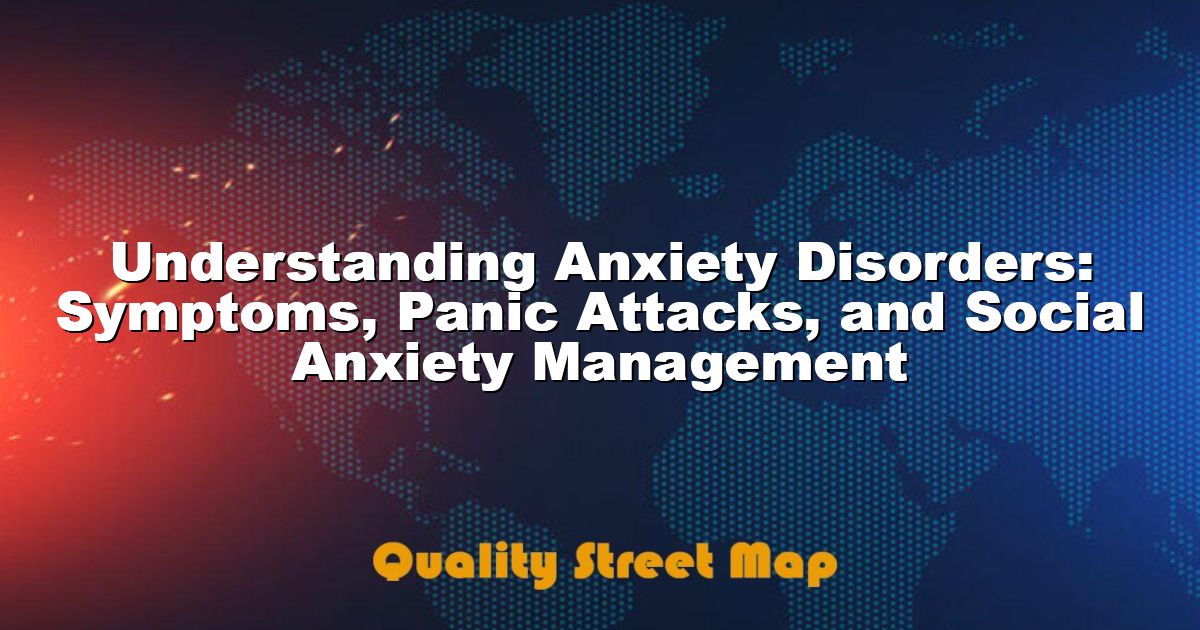Understanding Anxiety Disorders: Symptoms, Panic Attacks, and Social Anxiety Management

Introduction To Understanding Anxiety Disorders
When delving into the world of mental health, the importance of understanding anxiety becomes clear. Anxiety disorders are among the most common mental health concerns, affecting millions globally. These disorders encompass a range of issues characterized by excessive fear or worry that can interfere with daily life. Recognizing the signs and symptoms is the first step in addressing these conditions effectively.
Anxiety is not just a fleeting feeling of worry or fear; it’s an overpowering, persistent emotion that can affect every aspect of life.
One way to begin understanding anxiety is to explore the various types of anxiety disorders. These conditions manifest in diverse ways, each with its unique symptoms and challenges. By identifying these disorders, individuals can seek appropriate strategies to manage their symptoms and improve their quality of life.
- Generalized Anxiety Disorder (GAD)
- Panic Disorder
- Social Anxiety Disorder
- Specific Phobias
- Obsessive-Compulsive Disorder (OCD)
- Post-Traumatic Stress Disorder (PTSD)
- Separation Anxiety Disorder
The experience of living with an anxiety disorder can be challenging. Daily activities, social interactions, and even professional responsibilities can become burdensome when anxiety looms large. It is crucial to remember that anxiety is a highly personal experience—what works for one person may not work for another. Therefore, personalizing care and treatment is essential for effective management and recovery.
Symptoms Of Panic Attacks
In our journey of understanding anxiety, it’s crucial to delve into the symptoms of panic attacks, which can be both challenging and frightening. A panic attack is an intense wave of fear that strikes suddenly and often without warning. These attacks can manifest physically and psychologically, disrupting daily life and impacting one’s overall well-being. Recognizing the onset of a panic attack is essential for applying effective coping strategies. It’s important to acknowledge that panic attacks are common and manageable with the right approach.
Recognizing Signs Of An Impending Panic Attack
- Sudden and overwhelming fear or dread
- Difficulty breathing or feeling short of breath
- Rapid heart rate or palpitations
- Sweating or trembling
- Feeling unsteady, faint, or dizzy
- A sensation of choking
- Detachment from reality or oneself
While identifying the signs is a significant step, it is equally beneficial to understand the breadth of symptoms affected by panic attacks, including both physical and psychological aspects. A well-rounded understanding will aid in crafting a more effective response, reducing the sense of helplessness often experienced during these episodes. The ability to identify various symptoms can prove invaluable when seeking to manage or prepare for potential panic attacks.
Physical Symptoms
Panic attacks can manifest through a variety of physical symptoms that might mimic other medical conditions, often leading to confusion and heightened anxiety. Common physical symptoms include a pounding heart, trouble breathing, and sensations that can closely resemble a heart attack. Muscle tension, tightness in the chest, and clammy skin are also prevalent. These symptoms can be profoundly uncomfortable, but it’s important to recognize them as part of a panic episode. Understanding anxiety in this context helps in distinguishing panic-related symptoms from other ailments.
Psychological Symptoms
Psychological symptoms during panic attacks can be just as distressing as the physical ones. Individuals may experience a sense of impending doom, fear of losing control, or even fear of dying. Additionally, a panic attack might cause feelings of unreality or detachment, which can aggravate the situation. These symptoms often create a sense of vulnerability, making it vital to approach these episodes with a clear understanding of their nature. Effective management can significantly reduce the impact of these psychological symptoms, promoting a more balanced response to panic attacks. “The mind is its own place, and in itself can make a heaven of hell, a hell of heaven.” Understanding this aspect can empower individuals to reclaim control amidst the chaos.
Analyzing The Impact Of Social Anxiety
Social anxiety can have a profound impact on an individual’s day-to-day life. For those struggling with this condition, understanding how it manifests is crucial. The pervasive nature of social anxiety often results in a constant worry about social interactions and can escalate to avoiding social situations altogether. This avoidance not only perpetuates the fear but additionally limits personal and professional growth opportunities. By gaining a Understanding Anxiety, individuals can begin to recognize patterns and work towards overcoming these challenges. Social anxiety is a complex issue that necessitates attention to improve overall well-being.
Steps To Identify Social Anxiety
- Notice frequent fear or anxiety around social situations.
- Observe avoidance behaviors regarding social events or interactions.
- Recognize physical symptoms such as increased heartbeat or sweating when anticipating social encounters.
- Identify negative self-talk or fear of embarrassment in social settings.
- Acknowledge excessive concern about others’ judgments or opinions.
- Reflect on patterns of avoiding or leaving events early.
- Consider the impact of these behaviors on daily functioning and relationships.
Given the impact of social anxiety on one’s daily life, the cognitive and emotional toll can be significant. Individuals may find themselves trapped in a cycle of negative thinking that exacerbates their fears and inhibits social functioning. It is not uncommon for these cognitive distortions to become habitual, further entrenching feelings of inadequacy or judgment from others. Identifying these patterns can be the first step towards regaining control and enhancing one’s quality of life. Through a comprehensive Understanding of Anxiety, both the root causes and treatment options can be identified, paving the way for positive change.
Effect On Lifestyle
Social anxiety can greatly alter one’s lifestyle by restricting activities and opportunities that foster growth and connection. Individuals might forgo pursuing hobbies, engaging in social events, or even advancing in their careers due to fear of social scrutiny. This self-imposed isolation not only limits life experiences but can also contribute to feelings of loneliness and depression. The cycle of avoidance feeds into the anxiety, making it even more difficult to break free from these constraints. Understanding and addressing lifestyle changes can be vital in reversing these tendencies.
Cognitive Effects
The cognitive impact of social anxiety can be profound, as it often leads to distorted thinking patterns. Rumination over past interactions, fear of future social encounters, and constant negative internal dialogue can dominate an individual’s thought processes. These cognitive patterns may create a persistent cycle of anxiety that is challenging to disrupt without focused intervention. Recognizing these thought patterns and challenging them with a more balanced perspective is essential for cognitive restructuring. Embracing a deliberate approach to modifying these thoughts can diminish their influence and promote an overall sense of mental well-being.
Social Interaction Challenges
For those with social anxiety, engaging in social interactions may seem daunting, leading to withdrawal and isolation. These challenges can manifest in various scenarios, from informal gatherings to professional settings, affecting personal and professional relationships. Encouraging open communication and providing supportive environments can alleviate some of the pressure individuals feel. It’s important for those affected to realize they are not alone and that seeking assistance is a positive step towards overcoming these barriers. With a well-rounded Understanding of Anxiety, both individuals and their support systems can work together to foster more fulfilling social connections.
Strategies For Managing Anxiety
When it comes to effectively embracing understanding anxiety, developing suitable strategies is essential. Adopting the right approaches can help individuals manage anxiety disorders, calming symptoms and promoting a balanced lifestyle. It’s important to recognize that anxiety, whether in the form of panic attacks or social anxiety, requires a comprehensive approach for effective management. Combining different methods can lead to better outcomes, aiding individuals in overcoming the barriers caused by anxiety. Implementing such strategies can significantly improve one’s quality of life by reducing anxiety’s adverse effects.
Practical Management Techniques
- Engage in regular physical activities to reduce stress levels.
- Establish a consistent sleep schedule for improved mental health.
- Prioritize nutritious meals to support overall well-being.
- Set aside time for hobbies to foster relaxation and enjoyment.
- Practice deep breathing exercises to alleviate anxiety symptoms.
- Allocate time for socializing to build strong support networks.
Integrating these practical management techniques into daily routines can make a substantial difference in managing anxiety. While each person’s experience with anxiety is unique, these techniques provide a foundation for controlling its impact. It’s crucial to remain patient and persistent, as change takes time. Additionally, seeking professional guidance may provide further personalized insight and recommendations for managing anxiety disorders effectively. Collaborating with healthcare professionals ensures a well-rounded approach to treatment.
Cognitive Behavioral Therapy
Cognitive Behavioral Therapy (CBT) stands out as a highly effective treatment method. This therapeutic approach focuses on altering negative thought patterns, which are often the root cause of anxiety. By working with a skilled therapist, individuals learn to recognize and counteract distortive thoughts that contribute to anxiety. Through CBT, new coping mechanisms are developed, allowing for cognitive restructuring and a shift toward a more positive mindset. These changes often lead to a significant reduction in anxiety symptoms, with long-lasting effects that empower individuals to lead more fulfilling lives. As one therapist wisely states,
Changing your thoughts can change your life.
Mindfulness Practices
Incorporating mindfulness practices into daily routines can also play a pivotal role in managing anxiety. Mindfulness encourages living in the present moment, helping to reduce anxiety triggered by worrying about the past or future. Techniques such as meditation, yoga, and progressive relaxation can increase self-awareness and foster mental clarity. These practices build resilience against stress, improving one’s capacity to manage anxiety in challenging situations. By regularly engaging in mindfulness, individuals gain better control over their emotional responses, leading to a more peaceful and centered state of mind. Such practices are essential for achieving long-term relief from anxiety disorders.
Conclusion: Key Insights And Next Steps
In the journey towards understanding anxiety, it is essential to acknowledge the complex nature of anxiety disorders and their profound impact on individuals’ lives. Recognizing the symptoms of panic attacks and the challenges associated with social anxiety can lead to more effective management strategies. By increasing awareness and understanding, we can help those affected by anxiety to find the support and resources they need. It is important to remember that seeking professional guidance is a critical step towards improvement.
Professional treatment combined with self-help strategies can significantly enhance one’s quality of life.
Understanding the diverse aspects of anxiety paves the way for individuals to take actionable steps to manage their condition. Drawing on a combination of interventions tailored to personal needs can improve mental health and well-being. Strong support networks, including therapists, family, and friends, are crucial in this journey. While there are challenges, having a structured plan can make a significant difference in the effectiveness of anxiety management.
Final Recommendations For Managing Anxiety
- Consult with a healthcare provider to develop a personalized treatment plan.
- Practice regular mindfulness and relaxation techniques to reduce stress.
- Engage in regular physical activity to promote overall well-being.
- Utilize cognitive-behavioral strategies to address negative thought patterns.
- Build and maintain strong social support networks.
- Educate yourself about anxiety and stay informed about new research.
- Consider joining support groups for shared experiences and advice.
Adopting a proactive approach is paramount in managing anxiety effectively. Incorporating these recommendations into daily life can help alleviate the burden of anxiety disorders and lead to more fulfilling experiences. Each step, no matter how small, can contribute to long-term relief and peace of mind. While the path may not always be straightforward, perseverance and the right support can make all the difference.
As we continue to deepen our understanding of anxiety, it becomes clear that education and compassion are vital components. By fostering a supportive environment, society can help reduce stigma and encourage open dialogue. This approach will ultimately lead to more resources and research, further benefiting individuals affected by anxiety disorders. Embrace each stride forward as a meaningful advancement towards a healthier, more stable mental state.















